Encephalartos hirsutus
Encephalartos hirsutus P.J.H.Hurter
Family: Zamiaceae
Common names: Venda cycad (Eng.); Venda-broodboom (Afr.)
SA Tree No: 14.6
Introduction
The Venda cycad is an extremely rare and highly sought-after cycad, which is reportedly now extinct in the wild, as a result of illegal harvesting for private collections. This species is endemic to South Africa, and known from a very restricted area in three separate localities in the Soutpansberg region of the Limpopo Province; it grows in open grassland and shrubland on the slopes of low granite hills.
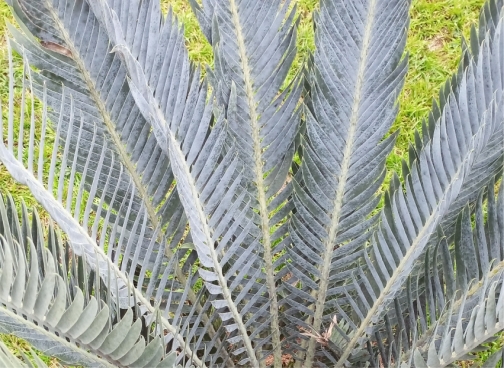
Description
Description
Encephalartos hirsutus has an aerial, unbranched stem, up to 3-4 m or rarely 4.2 m long and 350-400 mm in diameter. It is erect, but often leaning to some extent, especially when tall, and often suckering at the base. The stem apex crown is often covered by a dense brown woolly layer, which turns greyish with age. Leaves are arranged in a dense crown, rigid, bluish-green on the upper side and paler green on the lower side, up to 1.3 m long and with the apex recurving slightly. New leaves and the rachis are covered with dense wool, which persists until mature. The underside of the leaflets have longitudinal ridges, leathery with many nodules, which appear to be absent because it is largely covered with dense wool, 130-170 mm long, 20-24 mm wide The leaflets shield one another, especially at the leaf tip, incubously (when only the upper margins of the leaflets can be seen when a leaf is held horizontally and is viewed from above). Leaf margins are entire, with the lower being slightly recurved. Basal leaflets are reduced in size but not to a series of spines. Petiole is 300 mm long, covered with dense wool, which persists until mature. Both female and male cones are blue-green with a waxy hairless surface. Male cones are narrowly ovoid, 500 mm long, 90 mm in diameter, with a peduncle 120 mm long. Up to five cones per stem and pollen shedding taking place in late summer (November to January). Female cones are ovoid, 1-3 cones per stem, 400 mm long and 350 mm in diameter, appearing sessile but with a peduncle up to 60 mm long, hidden amongst cataphylls in the trunk crown. Seeds are orange-red, 30-35 mm long, 15-18 mm in diameter.
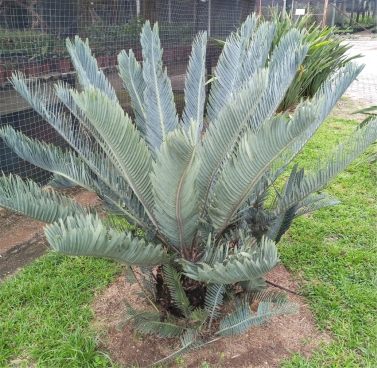
Conservation Status
Status
Encephalartos hirsutus is listed as Critically Endangered (Possibly Extinct in the Wild), by the IUCN (International Union for Conservation of Nature). According to the Red List of South African plants website, when this species was described in 1996, the original population was estimated to be 400–500 plants. In 2004, surveys located only 219 plants, with the majority remaining at a single location. In 2006 no plants could be found and this species was considered to be possibly Extinct in the Wild, or otherwise with only a few plants remaining. While a recent assessment in 2020 by the IUCN reported that none of the known specimens of E. hirsutus could be located, because parts of the original range comprise rugged mountainous terrain, it is possible that other specimens exist and there are ongoing surveys to locate and verify plants of this species. The estimated number of mature individuals in the wild is 0-10. This species has effectively been extirpated in the wild due to over-collecting for ornamental purposes. Furthermore this species is a slow grower and historically, it was never abundant in the wild. Small and restricted cycad population decline has been associated with an increasingly male-biased sex ratio (4:1), which may be a result of the targeted collecting of female plants, a phenomenon that has increased significantly in recent years, or differential mortality of female plants. (Da Silva et al. 2012)
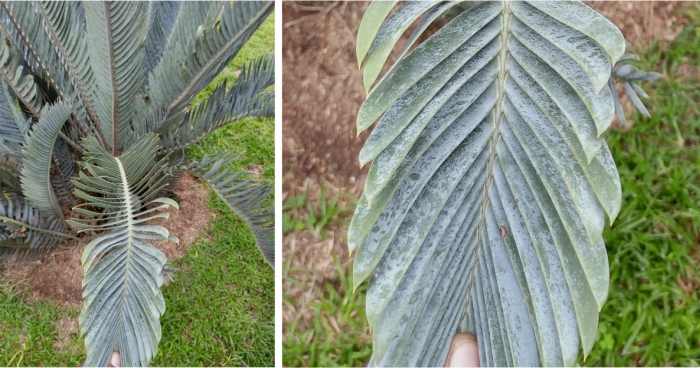
Distribution and habitat
Distribution description
This cycad occurs in three widely separated localities, in the northern parts of Limpopo Province. Plants from the different localities differ in their hairiness and the s-angle of the leaflets. All three forms are found in moist, semi-deciduous mixed scrub, often obscured by the dominant Androstachys johnsonii trees, on southeast-facing quartzite cliffs in association with Adenia spinosa, Barleria bremekampii and Eragrostis superba, in full sunlight at elevations of 800-1 000 m mm above sea level and receive an annual rainfall of 350-650 mm in summer. Encephalartos transvenous is the other cycad occurring nearby.
Derivation of name and historical aspects
History
The genus Encephalartos was described by the German botanist Johann Georg Christian Lehmann in 1834. The generic epithet is derived from Greek and means ‘bread in head’ and refers to the floury, starchy material in the trunks of some species, which is used as famine food by local people. This species was described in 1996 by P.J.H. (Johan) Hurter and Hugh F. Glen. The specific epithet hirsutus refers to the hairiness of the leaves.
Cycads are considered to be the most threatened taxonomic group of organisms, according to the IUCN (2023), with more than 69% of the species facing imminent extinction in the wild as a direct result of anthropogenic activities. Cycads are the oldest known seed-bearing plants. Cycads are often confused with both palms and tree ferns because of a superficial resemblance, however, they are actually totally unrelated. In fact, the name cycad is even derived from the Greek word cyckos meaning ‘palm-like’. Cycads are grouped into 3 families: Cycadaceae, Stangeriaceae and Zamiaceae. Currently there are about 343 species of cycad recognized worldwide and they are naturally found in the tropical, subtropical and warm temperate regions of Africa, Asia, Australia, and North and Central America.
The African continent is regarded as an important centre for cycad diversity, with representatives of all the cycad families (Cycadaceae, Stangeriaceae and Zamiaceae). South Africa is one of the global cycad hotspots with 38 of the described 343 species, including more than half of the known African species, occurring in the country. Sadly, South Africa also has the highest number of species classified as Extinct in the Wild, and is the only country with recent cycad extinctions (in the last decade) (Donaldson 2012) and also the highest proportion (12 out 37) of critically endangered species of which some of them are now presumed Extinct in the Wild.
The Venda cycad should be not be confused with any other species because all parts the leaves remain very hairy for most their life, leaflets incubously orientated with prominent longitudinal ridges on undersides, which is unique among the southern African cycads.
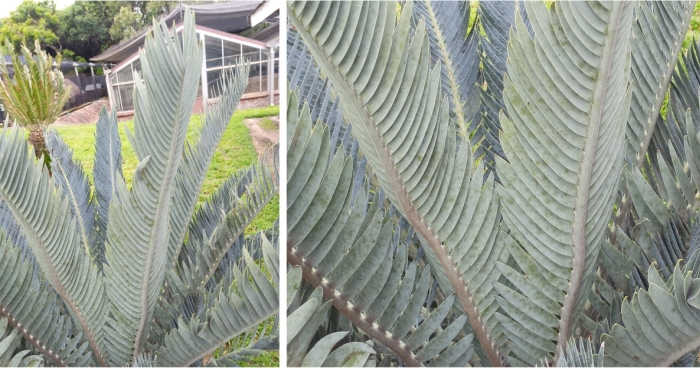
Ecology
Ecology
For a long time it was thought that all cycads were wind pollinated, as most coniferous plants are, and the fact that cycads generally produce high volumes of pollen, supported this argument. However, objections were raised based on the following points: species such as Encephalartos cycadifolius, E. ghellinckii, E. heenanii, E. friderici-guilielmi and E. lanatus have very woolly cones, which make it difficult for wind pollination to happen. Other cycad species such as E. villosus and Stangeria eriopus occur in forest where there is no wind. Current research shows that insects are the pollinators of all 10 cycad genera. Most cycads are thermogenic (able to produce heat) and emit volatile odours. In nature when the male cone reaches maturity, the central axis elongates and the scales move apart to make room for the release of the pollen, which is distributed by insects. The release of pollen varies between species but usually lasts for two weeks, on average. At the same time, the female cone also reaches maturity, the cone heats up, causing it to elongate, and it produces a smell, which attracts the insects, the pollen vectors, to the female cone. The scales move apart to allow the insects to enter and to pollinate the cone.
The fleshy outer coat of the seed is eaten and the seeds dispersed by animals, mainly birds, rodents, small mammals and fruit-eating bats.
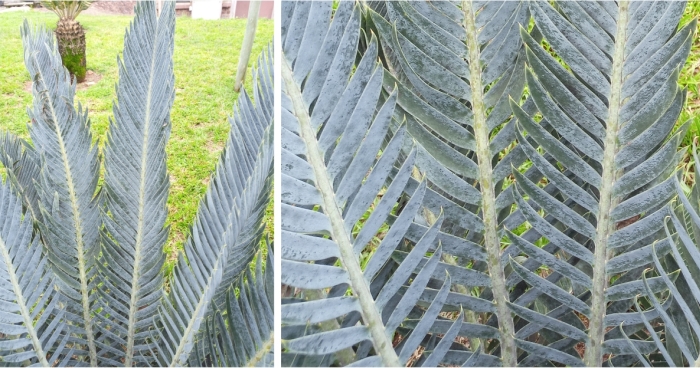
Uses
Use
In isiZulu language, most of the cycads are referred to as isqgiki–somkhovu. This name refers to witchcraft practices, where a person is converted into becoming a zombie and is used for witchcraft. The cycad is planted in front of the gate of the homestead to protect it from the evil spirit. If someone practices any witchcraft using umkhovu, this zombie will sit on top of the cycad, which is referred as isqgiki, which means ‘chair’, and that is where the common name is derived from.
The impact of poaching on E. hirsutus has been severe and as a result this species is reportedly now extinct in the wild. This species is highly desirable in the horticultural trade. They are very expensive and can only be observed in elite private collections. Therefore obtaining seeds and seedlings is difficult and expensive. It is reported that only one individual apparently remains in an inaccessible location on a private nature reserve.
Growing Encephalartos hirsutus
Grow
Encephalartos hirsutus grows best in full sun but also tolerates light shade and is frost tolerant. This species is a slow grower, it does well in cultivation provided that it is planted in well-drained soil and does not do well with excessive moisture. It is propagated from seeds and suckers.
In cultivation artificial pollination is necessary for a successful seed harvest. Regular visits to the male plants are necessary to note the date on which a cone appears. In this way it is possible to estimate when the cone will be ready for harvesting. Pollen should be collected as soon as it starts shedding. Pollen should be stored at -15°C.
The female cone scales have to be monitored to check when they are open. Individual plants vary in the duration of scale-opening, from three days to two weeks. After female cones have been collected the seed is left to mature for a year before sowing at the beginning of summer. Stored seed can be sown in summer, in river sand and placed on a heated bench at 24–28°C. Germination should start 4–6 weeks after sowing. However, some seeds will take longer, especially where there is no heat.
When a sucker reaches a size of about 80 mm diameter, dig the soil away from around the main cycad to expose the sucker and clean any dirt from the sucker and the main cycad. Use a sharp, clean, cutting tool, such as a saw, chisel or knife, to cut off the sucker. Make a clean cut at the point of attachment of the sucker to the main plant. As a precaution, especially with valuable species, apply fungicide, sulphur or a tree seal to the cut area, on both the sucker and the mother plant, to prevent disease and attacks by pests.
If the sucker is large enough (minimum of 250 mm) and it has enough roots, it is best to immediately plant it straight into the ground. Smaller suckers and suckers with no roots of their own must be taken to the nursery, where they should be left in a cool, dry area to dry for a few weeks, to allow the wounds to form a callus, before potting.
References
- Bösenberg, J.D. 2022. Encephalartos hirsutus. The IUCN Red List of Threatened Species 2022: e.T41889A51056445. https://dx.doi.org/10.2305/IUCN.UK.2022-1.RLTS.T41889A51056445.en.
- Da Silva, J.M., Donaldson, J.S., Reeves, G. & Hedderson, T.A. 2012. Population genetics and conservation of critically small cycad populations: a case study of the Albany cycad, Encephalartos latifrons (Lehmann). Biol J Linn Soc. 105: 293–308.
- Donaldson, J. S. 2012. Encephalartos latifrons in: IUCN 2012. IUCN red list of threatened species. version 2012.2. [Online]. Available at: www.iucnredlist.org [Accessed 28 February 2013].
- Donaldson, J.S. 2009. Encephalartos hirsutus P.J.H.Hurter. National Assessment: Red List of South African Plants version 2020.1. Accessed on 2023/06/05.
- Goode, D. 2001. Cycads of Africa. Cycads of Africa Publishers, Gallomanor.
- Grobbelaar, N. 2002. Cycads with special reference to the southern African species. Published by the author, Pretoria.
- Hurter, P.J.H. & Glen, H.F. 1996. Encephalartos hirsutus (Zamiaceae): a newly described species from South Africa. South African Journal of Botany 62(1):46-48.
- Jones, D.L. 1993. Cycads of the world: Ancient plants in today's landscape. Reed, New South Wales.
- Raimondo, D., Von Staden, L., Foden, W., Victor, J.E., Helme, N.A., Turner, R.C., Kamundi, D.A. & Manyama, P.A. (eds) 2009. Red list of South African plants. Strelitzia 25. South African National Biodiversity Institute, Pretoria.
- Ulwazi, Sharing indigenous knowledge. Isihlahla sesigqiki somkhovu. https://www.ulwaziprogramme.org/2016/10/isihlahla-sesigqiki-somkhovu/ Accessed on 2019/01/23.
- Xaba, P.M.A. 2014. Pollination and germination as limiting factors in the propagation of threatened cycads, Encephalartos (Zamiaceae). MSc Thesis, University of Western Cape, South Africa.
Credits
Lungisani Zondi and Ntokozo Mnisi
Walter Sisulu National Botanical Garden
June 2023
Plant Attributes:
Plant Type: Shrub, Tree
SA Distribution: Limpopo
Soil type: Loam
Flowering season:
PH: Acid, Neutral
Flower colour:
Aspect: Full Sun, Morning Sun (Semi Shade), Afternoon Sun (Semi Shade)
Gardening skill: Average
Special Features:
Horticultural zones










Rate this article
Article well written and informative
Rate this plant
Is this an interesting plant?
Login to add your Comment
Back to topNot registered yet? Click here to register.